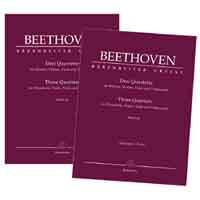Beethoven, Ludwig Van (Miucci) Quartets (3), woo 36
Piano Quartets

-
Beethoven, Ludwig Van (Miucci)
Quartets (3), woo 36 (Miucci)
Classical. For piano quartet (violin, viola, cello, piano). When Beethoven wrote these three quartets he was 15 years old and a composition student of Christian Gottlob Neefe in Bonn. They reveal a strong Mozartian influence while the brilliant piano writing already gives a sense of the mature Beethoven. He may conceivably have written the works for the wealthy Mastiaux family in Bonn, as he gave piano lessons to one of the daughters and the other three siblings played violin, viola and violoncello.The sole source for the quartets is the autograph score which contains many overwritings that shed light on the works' original conception and possible alternative readings. Although Beethoven never published the pieces in his lifetime and is not known to have performed them, he reused their melodic and thematic material in later compositions.
Beethoven preserved the autograph score to the end of his days - perhaps an indication that the quartets meant a great deal to him. The first edition was published by Artaria in Vienna one year after his death, albeit with the pieces in a different orderand with many errors in the musical text.
B„renreiter's scholarly performing edition of the Piano Quartets WoO 36 is edited by the Italian pianist Leonardo Miucci, a specialist in the performance practice of keyboard music from this period. The edition not only presents the correct readings, it also sheds light on the young Beethoven's expressive notation and provides a plausible explanation for the distinction he made between dots and strokes to indicate staccato.
-
- Category: Piano Quartets
- Item: 128084
- Grade/Level:
- Price: $62.95
-
(usually ships in 10 to 15 days)
